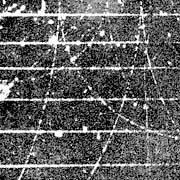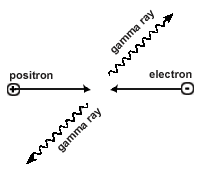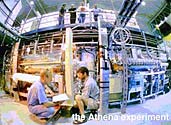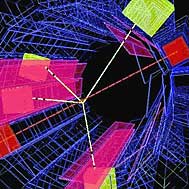Antihydrogen Antics
As StarTrek fans know well, the fuel for warp drive is antimatter. No science fiction stuff this—antimatter was predicted by Paul Dirac in 1928. At the time, the only known elementary particles were the positively charged proton and the negatively charged electron. Dirac combined the recently discovered quantum physics with special relativity and produced an equation that seemed to predict two kinds of particles: those with positive energies, as expected, and those with negative energies, which didn’t make any sense. After pondering this result for several years, Dirac realized that these negative energies actually correspond to “antiparticles” of positive energy with the same mass as protons and electrons but with opposite charge. (see The Buzz about Antimatter). More broadly, he theorized that for every particle there should exist a corresponding antiparticle.

Particle tracks in a cloud chamber

Positron-electron annihilation, before and after: Before, a positron and an electron approach each other. After, the two have annihilated into two gamma rays.
As Dirac was working out the significance of his equation, experimentalists were investigating particles of higher and higher energies. In those days there were no machines to accelerate particles, so investigators turned to Mother Nature. Raining down on Earth from all distant parts of the universe are particles called cosmic rays, which hit the atmosphere and set off a shower of secondary particles. A young physicist at Caltech, Carl Anderson, unaware of Dirac’s prediction, observed these particles by studying their tracks as they moved in a magnetic field. (See photo) One day Anderson noticed tracks that seemed to correspond to a positively charged electron. After doing more experiments to confirm this result, he reported in 1932 the existence of the positron, with the same mass as an electron but a positive charge. Only much later, in the 1950s, did physicists find the much more massive antiproton, because its discovery required a powerful particle accelerator.
When particle and antiparticle meet, they mutually annihilate. An electron and positron annihilate into two gamma ray photons (units of radiation), as shown in the diagram, and the gamma rays carry away the mass-energy of the particles according to E = mc2. For a proton and antiproton, annihilation produces four particles called pions. So the signature of antihydrogen annihilation is four pions and a pair of gamma rays, all coming from the same place, and with the right directions and energies.
Research
With the discovery of the positron and antiproton, physicists dreamed of combining them to make anti-hydrogen, the simplest atom made of antimatter. Examining how anti-hydrogen absorbs and emits light would permit a stringent test of particle theory, which says that anti-hydrogen’s energy spectrum should be identical to that of ordinary hydrogen.

The particle decelerator in the ATHENA project at CERN (photo courtesy of CERN)

An atom of anti-hydrogen annihilates to form two gamma rays and two pions. From observations of these annihilation products, physicists constructed this computer image. (image courtesy of CERN)
Physicists first produced antihydrogen at the CERN and Fermilab particle accelerators in the mid-1990s. A beam of antiprotons smashed into a target, creating many new particles, including electron-positron pairs. A few antiprotons and positrons did combine each day, but the best the experimenters could do was detect the antimatter atoms as they raced away at almost the speed of light.
But physicists want to study the antihydrogen, not just detect it, and to do this they need a large, confined sample. The challenges start with the production of the antiprotons, which requires extremely high energies, so once produced, these particles must be decelerated in what is essentially a particle accelerator run backwards. (See photo) Then the antiprotons enter a series of electric and magnetic traps, cooling them considerably more. In a parallel part of the experiment, positrons from radioactive decay are themselves trapped and cooled.
When positrons and antiprotons finally meet, in yet another trap, some combine to form antihydrogen. Since atoms, including those of antimatter, are electrically neutral, they no longer respond to the electric and magnetic fields and simply fall out of the trap and into annihilation on one of the metal electrodes. From the annihilation products, physicists detect atoms of antihydrogen, as shown in the computer image. The experiment yields about 50,000 antihydrogen atoms, starting from about 1.5 million antiprotons. This sample size is still too small for spectroscopy, but future experiments will increase the yield substantially.
Beyond the study of antimatter for its own sake, these investigations could help cosmologists understand the early history of the universe. The Big Bang should have produced matter and antimatter in equal amounts, but the observed universe seems to be made of only matter. The answer to the question of the missing antimatter could lie in some yet-to-be-discovered difference between hydrogen and antihydrogen.
Links
Nature
CERN
NASA

Cold antiproton trap (photo courtesy of CERN)














